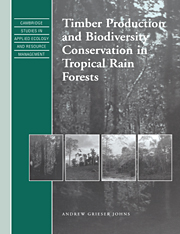Book contents
- Frontmatter
- Contents
- Foreword
- Preface
- Explanatory note
- 1 The issues
- 2 The history and development of tropical forestry
- 3 Changes in the physical environment
- 4 Forest regeneration and gap dynamics
- 5 Responses of individual animal species
- 6 Responses of species assemblages
- 7 Using ecological data in forest management planning
- 8 Intervention to maintain biodiversity
- 9 Field procedures
- 10 The future
- References
- Subject index
10 - The future
Published online by Cambridge University Press: 04 December 2009
- Frontmatter
- Contents
- Foreword
- Preface
- Explanatory note
- 1 The issues
- 2 The history and development of tropical forestry
- 3 Changes in the physical environment
- 4 Forest regeneration and gap dynamics
- 5 Responses of individual animal species
- 6 Responses of species assemblages
- 7 Using ecological data in forest management planning
- 8 Intervention to maintain biodiversity
- 9 Field procedures
- 10 The future
- References
- Subject index
Summary
Integrated management of tropical forests
Management priorities
Land use plans for tropical countries need to take into account the needs of (often expanding) rural populations. This is generally paramount in development programmes. Where the proportion of forest land is low compared with population density, forests will need to be shown to be economically productive, either through direct utilization or in providing jobs. Protected areas can only be justified to local populations if they generate revenue from ecotourism or other sources, or if they provide clearly demonstrable benefits as water catchment areas, etc.
Most forest areas in the tropics will be utilized in some way and the challenge for development programmes is to ensure that forms of utilization are sustainable. This has rarely been the case to date (Kremen et al. 1994). In many regions community use of forest products is longstanding, and future programmes will need to concentrate on its development and regulation. In other areas, the development of agroforestry or community forestry programmes may need to be encouraged in order to provide sources of fuelwood and construction timber that may not be available from reserved forests. The control of commercial forestry is rarely vested in local communities and this may be a requirement for change.
In less populated countries, it may be possible to preserve large areas of tropical forest providing some benefits accrue to the administrative authorities.
- Type
- Chapter
- Information
- Publisher: Cambridge University PressPrint publication year: 1997

